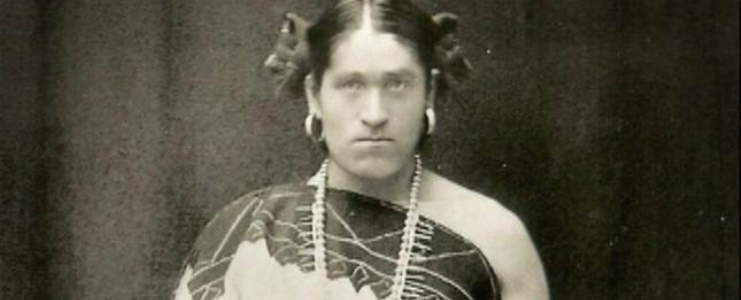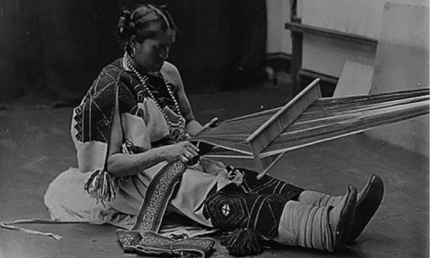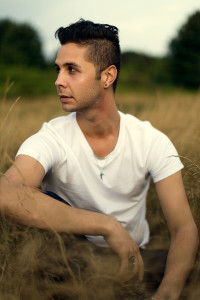
Two spirit — the movement, the societies and the term itself — marks a return to Native American traditions that historically recognized more than two genders.
By Zachary Pullin (Chippewa Cree)
This article originally appeared in Native People’s Magazine and Kosmos
Growing up, I never truly felt like dancing at powwows. I spent my early childhood on the Rocky Boy Reservation in Montana before moving to Spokane, Washington, with my family, and despite a warm and welcoming upbringing, I never entered the dance arena with confidence like the male grass, Plains traditional and fancy dancers at grand entry.
I had grown up with the idea in my own mind that I was less of a man, and also, being both physically or characteristically different, I felt vulnerable in expressing myself in those circles. Even if the notion was all in my head, there was a deep sense that I couldn’t present my whole self in that space.
I was different because I was two spirit, meaning a Native LGBTQ person.
It wasn’t until I attended a two-spirit gathering—a cultural event that draws together two-spirit individuals for traditional dancing, storytelling and other customs—that I entered a dance arena and felt authentic about who I was in my place in the circle. While I don’t wear regalia, like many of the others, I still join in when invited, not feeling I should defend or hide my identity as a gay or Native man.
I am part of the Native American gender tradition that has come to be defined in modern times as “two spirit.” The term stems from the Ojibwe phrase niizh manidoowag and replaces the outdated, oversimplified term berdache, which appeared frequently in research and anthropological studies that aimed to describe the place of gay men in Native society in the 18th and early 19th centuries. Berdache is a derivative of a French term meaning “kept boy.” So not only is the word offensive, it also falls short in defining the diverse experiences of Native people who weren’t of only the male and female genders in their cultures.
The phrase “two spirit” began to gain traction across Native America after 1990, when 13 men, women and transgender people from various tribes met in Winnipeg, Canada, with the task of finding a term that could unite the LGBTQ Native community. Numerous terms in tribal languages identified third genders in their cultures that encompassed both masculine and feminine, and the struggle for those gathered in Winnipeg was finding a contemporary term that would be embraced across all tribal cultures.
The attendees at the gathering settled on “two spirit.” They wanted a term that “reflected the combination of masculinity and femininity which was attributed to males in a feminine role and females in a masculine role,” says author Sabine Lang in the book Men as Women, Women as Men: Changing Gender in Native American Cultures. Many two spirit, historically, were keepers of traditions, tellers of the stories of creation, and healers.

Courtesy of The Guardian.
The efforts of those in Winnipeg proved necessary in the years that followed. Anti-transgender bias and persistent structural and interpersonal acts of racism have been especially devastating for American Indian and Alaska Native transgender people, according to a 2012 report by the National Gay & Lesbian Task Force. And there are tragic stories that support this finding, including that of Fred Martinez (Navajo), a 16-year-old transgender person who was murdered in a violent beating near Cortez, Colo., in 2001. Martinez’s story is told in the 2011 documentary Two Spirits, which also looks at the history of gay identity in many Native cultures. Martinez was nadleeh—in the Navajo language, “the changing one,” a person whose gender identity exists beyond male or female.
Although not all tribes identify or name a concept for gender or sexual-orientation-variant members, many of them have, including the Zuni, withlhaman; the Lakota, with both lila witkowin and winkte; and the Plains Cree, my people, with a’yahkwêw. At least 165 tribal gender traditions existed in North America historically, when many of our Native cultures accepted and respected individuals encompassing a balance of both feminine and masculine qualities.
The two-spirit tradition centers primarily on gender, not sexual orientation, and the distinction is important. While sexual orientation describes the sexual relationship that a person of one gender has with another person, gender describes an individual’s expected role within a community.
Many of the great visionaries, dreamers, shamans or medicine givers were two-spirit people. Among the Crow, Ohchikapdaapesh, also known as Woman Jim, gained prominence in the 1870s by joining a battle against enemy tribes. Woman Jim earned the name Finds-Them-and-Kills-Them and was an accomplished craftsperson of the Crow tribe. As a boté, a term for a two-spirit person in Crow, Woman Jim made large tipis and other leather goods intricately decorated with quill- and beadwork.
Among the Navajo, weavers are usually female, and hataalii—singers, chanters or medicine men—are usually male. Many times Hastiin Klah, in early life known as Charlie the Weaver, identified as a nadleeh. Klah filled both male and female roles, becoming a renowned spiritual chanter and developing a weaving style still used today.
One of the most well-known two spirit in history is We-wha, an honored Zuni Pueblo cultural ambassador who traveled to Washington, D.C., in 1886 and shared the story and values of her people, who live in what is now western New Mexico. In Zuni tradition, We-wha was referred to as lhaman, or mixed gender. Many lhaman expressed as female, took on female gender roles and served as mediators. Tall and broad shouldered, she was a skilled potter and weaver of the Zuni people.
On any given reservation today there can be different levels of acceptance and understanding, and not all Native communities regard two spirit equally. There are complicated debates about the rights of LGBTQ Native men and women on reservations, like the one taking place on the Navajo Nation, where LGBT rights advocates have received support from some and resistance from others in their attempt to undo the 2005 Diné Marriage Act, which defines marriage as being only between a man and a woman
But there are also signs that Native people—gay and straight—are returning to a culturally connected awareness of who two-spirit people are and what they have contributed. In many cases, the clearest indications of acceptance have come from tribes themselves. At least seven Native governments in the United States have passed laws recognizing same-sex marriage since 2008, and when the tribes took action, most did so in states where same-sex marriage was not yet legal, like the Suquamish near Seattle.
The Suquamish law came at the request of tribal member Heather Purser, who at age 28 asked for a vote on the issue in 2011—a year before the state of Washington recognized same-sex marriage. More than a year after initial conversations with some tribal leaders on the issue, she decided to take her proposal to the people. As she stood at the annual tribal meeting, hands trembling and with a slightly sweaty forehead, she asked her fellow Suquamish citizens in attendance to allow marriage rights for all people in the tribal law. Purser remembers that day vividly.
“We are braided together, indefinitely braided together. For the rest of our lives—for the rest of the history of our people,” she recalls telling the crowd of 300.
Once her swift appeal was finished, the crowd voted unanimously in favor of same-sex marriage, making it the first jurisdiction in the state of Washington to do so. “It was less a vote and more an affirmation of me and an understanding of my struggle,” Purser says. For Purser, coming to terms with her two-spirit identity was part of a larger journey of self-acceptance. Understanding two-spirit history helps her “understand—more fully—my own beautiful complexity” as a woman, Native American and LGBT person, she says.
For me, the term “two spirit” resists a Western definition of who we are and what we should be. Two spirit are integral to the struggle of undoing the impacts of historical trauma, because our roles in tribes historically were part of the traditions taken away from us with Westernization. We aren’t attempting necessarily to convince the Native community that we exist—historically and presently—but that our history is just as much wrapped up in the story of Indian Country as is each other Native American’s.
Two spirit—the movement, the societies and the term itself—marks a return to a tradition that historically recognized more than two genders. It’s meant to honor Native American languages and traditions that were nearly forgotten in some cases.
“We’re reclaiming our place in the circle,” said Steven Barrios, of the Montana Two Spirit Society, at a Two-Spirit Gathering in Tulsa, Okla. “Until the two-spirit people are brought back into that circle, that circle is never going to be completely mended.”
As two-spirit people, we are finally ready for our grand entry.
 Zachary Pullin (Chippewa Cree) is the communications coordinator for the Krista Foundation for Global Citizenship, and a member of the Gender Justice League, Northwest Two Spirit Society and Native American Advisory Council for the Seattle Police Department. He lives in Seattle. Follow him on Twitter: https://twitter.com/zacharybob
Zachary Pullin (Chippewa Cree) is the communications coordinator for the Krista Foundation for Global Citizenship, and a member of the Gender Justice League, Northwest Two Spirit Society and Native American Advisory Council for the Seattle Police Department. He lives in Seattle. Follow him on Twitter: https://twitter.com/zacharybob
The opinions expressed in this article are those of the author and do not necessarily reflect those of the Diverse Elders Coalition.

